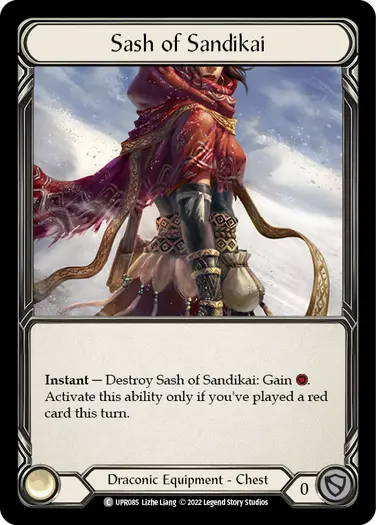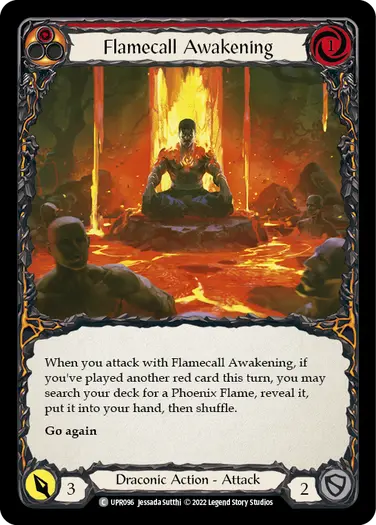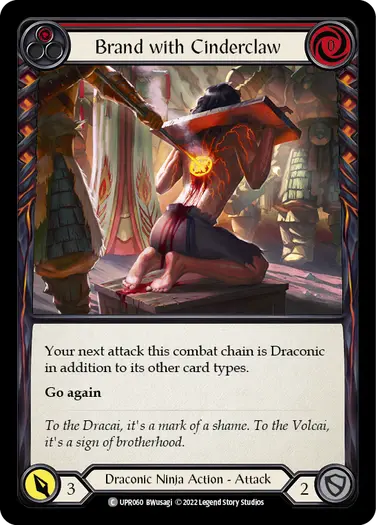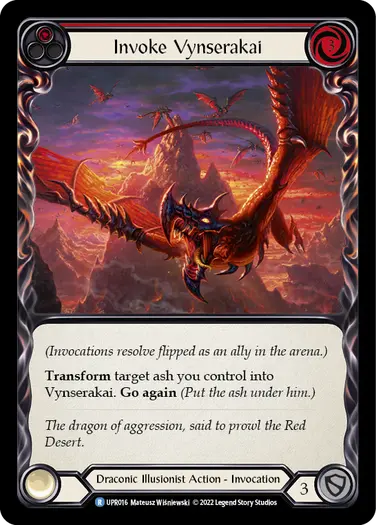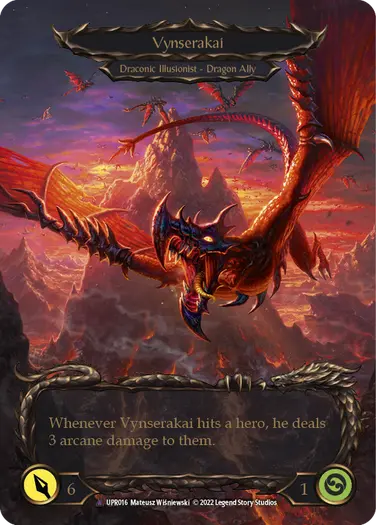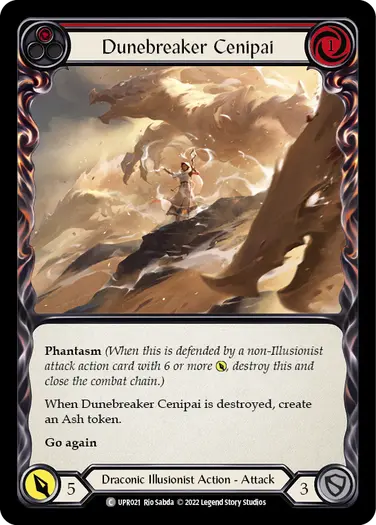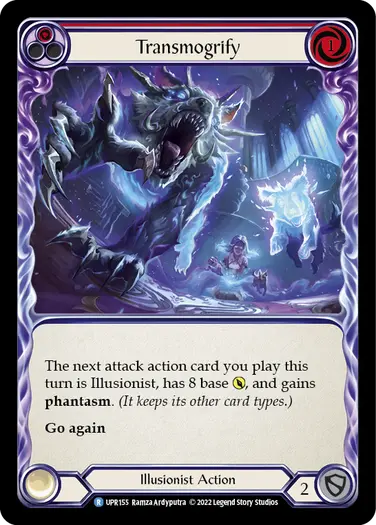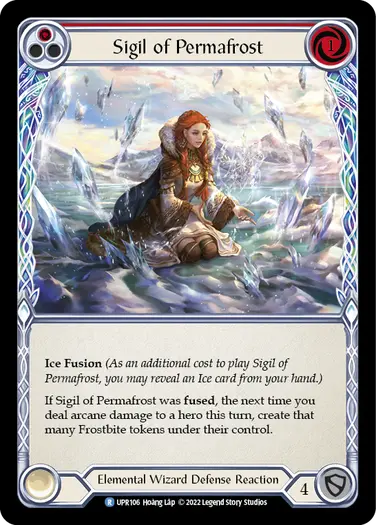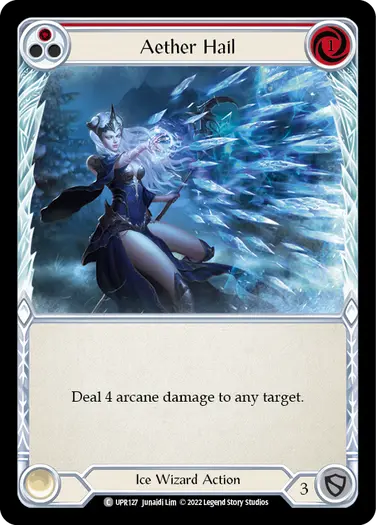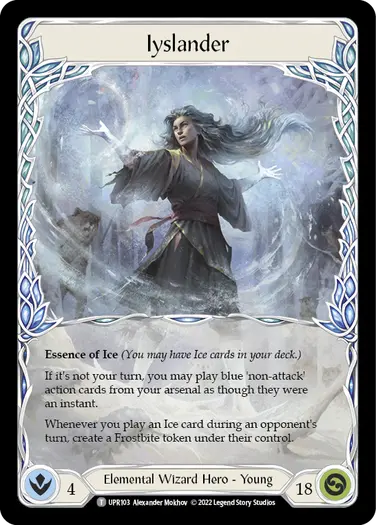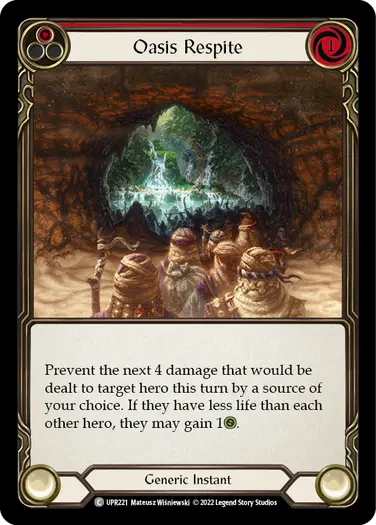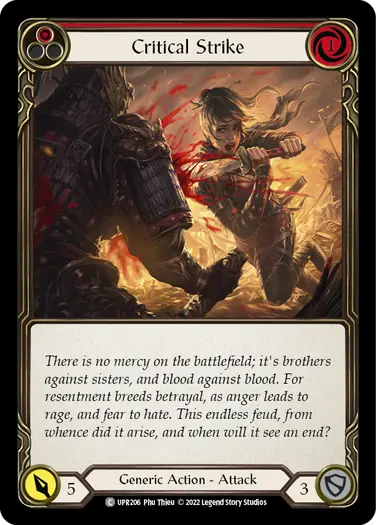We've invited some guest writers to contribute to fabtcg.com in the lead-up to the release of Uprising. Matt di Marco is known for both video and written content, including interviews, articles, and most recently, broadcasting.
The lights of Las Vegas have finally faded from my bright eyes. Landing back home in Toronto after three days of celebrating Flesh and Blood at the Uprising Premiere event in Nevada has given me much needed rest, but also some perspective on what the post-UPR scene will look like from a competitive standpoint. Having gotten down and dirty with a sealed pool on the Friday of the event, which also happened simultaneously in Madrid and Sydney, I have a better understanding of how to approach UPR Limited. In short, it feels fiery and aggressive, but there are pillars to lean on that will suit your style nicely.

The Devil You Know
Before getting into the thick of each hero’s toolbox, and finding the right avenue of attack when building your deck, I have to emphasise that comfort and familiarity are often your best assets to achieving success. Your sealed pool of six packs can often seem intimidating when there are no obvious build-around cards pulled from your packs. Without hitting big on pulling a Legendary piece of equipment, the task of building your deck can be daunting without clear signals of which hero to trust your deck with. Familiarity and experience can oftentimes be your best asset.
The heroes of Uprising are certainly unique, but they pull from past strategic ideologies that have already been well rooted in Flesh and Blood gameplay. Fai, the Ninja, will feel very similar to Katsu, who will swing for multiple low-level attacks to chip away and sustain annoying pressure. Dromai can certainly go taller by invoking an armada of dangerous dragons, or call on more Go Again attacks while annoying you with Ashwings. Iyslander is the outlier, opting to cool down the inferno of Draconic aggression by polluting the opponent’s gameplan with Frostbites and arcane sorcery.
These playstyles are not new, and there’s a good chance that you’ll immediately identify with one of these ideologies over another. I myself was quite happy to pilot Fai to a 4-2 record despite a moderate Ninja pool, merely because I’ve had so many repetitions with Katsu and Briar. Going wide and generating on-hits was something I was adept at. Choosing your hero may be as simple as doubling-down on your strengths and experience.

Fai
The consensus overall seems to be that Fai, the Draconic Ninja, is the most straightforward and supercharged option for the uninitiated. With a laundry list of red attacks, an endless array of Go Agains, and a very reasonable hero ability to recur your Phoenix Flames in front of the graveyard, Fai takes what Katsu started and lights a fire underneath it. Building Fai will be quite straight forward, as there are no real combo lines you’ll need to balance in order to punch above your weight. Your supply of cheap Go Agains will make the majority of your hands seem playable and potent, with your Searing Emberblade always there to keep the good times rolling.
Sash of Sandikai
Equipment has always been a high value commodity in Draft, but in Sealed you have nobody to compete with in acquiring your kit. Sash of Sandikai is a big part of Fai’s reach, acting as a quasi Fyendal’s Spring Tunic in some cases, allowing you to extend turns to breakpoints and deliver damage to an already stretched thin opponent. Finding Sash is a good reason to consider Fai.
Flamecall Awakening
No other card in the common pool will feel as good as Flamecall Awakening. Though the 1-cost may make you flinch a little (spoiled, aren’t we, Ninja players?), the ability to tutor and thin your deck for a free Go Again attack is incredible value. Think Belittle / Minnowism, but it is just easier to pull off. The criteria of the search effect isn’t difficult to satisfy, and once you cherry-pick and play the Phoenix Flame from your deck as a third link, you immediate activate Rupture effects, and have a free rescue of an additional Phoenix Flame with Fai’s game text. The card does absolute work.
Brand with Cinderclaw
Most of Fai’s cards will require a second chain link in order to develop value. Brand with Cinderclaw, especially in red, is the ideal opener to any searing turn you hope to toss at your opponent. A 0-cost Go Again that transforms your next attack into a Draconic link will clean up your combat chain to maintain the fiery pressure and connect for damage. Brand with Cinderclaw into Scar For A Scar makes two consecutive Draconic chainlinks, and can sometimes be important. Finding these cards is a great start to building your Fai list

Dromai
I’ll be first to admit that Dromai was intimidating. Though access to the Draconic talent pool opens up some aggressive options, Dromai’s bread and butter is invoking the wrath of dragons. I didn’t get many reps against Dromai, as she wasn’t a very popular option amidst the field, but the one Dromai I did face in Las Vegas gave me one hell of a showdown. The main indicator you want to look for is just how many dragons you’ve pulled and whether it is worth piecing together a deck that summons these beasts.
Vynserakai
The term glass cannon is tossed around a lot, but this card fits the bill. Against other Dromai or Fai, Vynserakai can emerge from the ashes to reign terror. Costing 3 resources, this dragon is a blue pitch away from swinging in for 6 physical damage. Your opponent will be devoting two cards at minimum to protect against this winged hellion, and should they give it clear skies to fly, it will buzz the tower for an additional 3 arcane damage. This dragon presents an explosive offensive option that forces opponents into donating cards to blocks, or getting razed for significant damage. Be weary, however, as the single point of health will make it easy pickings for an attack, and Iyslander may have options to kill it on your turn before it takes flight.
Dunebreaker Cenipai
The beauty of Limited format is that you can often rely on the unreliable. Players will not always have the solutions to easy problems that you’d otherwise face in a constructed format. A card with Phantasm feels risky, but without many attacks of 6 or greater to blow up Dunebreaker Cenipai, the card is a horse. For the tiny cost of 1, you’re getting an above-market rate damage output and a hefty three points of defense. Add on the unconditional Go Again, and this is a potent option to lead off an offensive. Should your opponent find the magic elixir to break it up, you’ll get an Ash token as a consolation prize along with the knowledge that they’re unlikely to have another big attack to trigger Phantasm.
Transmogrify
On the same train of thought that your opponent will run out of 6+ attacks to stuff your Phantasms, Transmogrify can be a nasty opening act to one heck of a horror show. Opening a turn with this card to follow up with a Phoenix Flame or Scar For A Scar is the kind of high octane offense that either closes out games, or buys back the tempo. In a format that plays between 18 and 20 life points, threatening to cut their health in half is enough to change the landscape of your match. Versus Iyslander who may be littering Frostbites all over you, you may only get the opportunity to present one swing. Might as well make it hurt. Transmogrify is a fixer that can amplify your pitiful blue attacks into haymakers.

Iyslander
Coming off of Pro Tour in New Jersey, a renaissance of interest in Wizard is well timed for Iyslander to truly dominate the format. Iyslander is like the other wizard in the other Wizard in the field: difficult to pilot, but devastating when masterfully manoeuvred. It is my opinion that Iyslander with a decent pool and a competent pilot can dumpster the field, making life miserable for the Draconic contenders. I played Fai against Yongji Yang on Iyslander at the draft event in Las Vegas. My pool was the strongest FAB deck I ever drafted, competing with only one other Ninja in my pod. Yongji made me look like an absolute muppet, killing me while only taking 3 points of damage which, honestly, was a courtesy because he had lethal in hand. Iyslander is the strongest hero in Limited if you know how to play Wizard and can find some key pieces.
Sigil of Permafrost
Sigil of Permafrost is a Defense Reaction that will do double duty. Pairing this card up with a blue non-attack from Arsenal on your opponent’s turn will create a myriad of issues, mucking up their game plan with disruptive Frostbite tokens. Iyslander will be doing a lot of her work on the opponent’s turn, so stretching value and adding a chilling insult to injury makes for a taxing experience for any Draconic player who was hoping to go wide on you. Absorbing damage in the reaction phase is certainly nice to have, too, but attack reactions aren’t really going to be on your radar. This is merely a way to halt a devastating turn before it gains altitude.
Aether Hail
Aether Hail is fairly pedestrian at first glance, but looking at it in conjunction with Iyslander’s ability, and her weapon Waning Moon, you can find a super-combo meal of deliciousness in one blue pitch. Firing this at an opponent on their turn will yield a Frostbite token, and leave you with two floating resources to activate Waning Moon. What you’ve accomplished for one blue pitch is 5 arcane damage and a Frostbite token which may flat out end their turn. There are certainly other more fearsome non-attack actions you can fling their way, but for efficiency’s sake, Aether Hail truly extends the value you obtain from one blue pitch.
The Wizard's Blues
The final piece for Iyslander is more-so pitch related than actual specific cards. Iyslander needs blues in the Arsenal to truly find her stride and convert on a gameplan. In Limited format, it is either feast or famine. Though you may have reps on Wizard, even have played a dozen or two games as the ice queen herself, but without a clip full of icy blue goodness, she’s going to fall flat. The appeal of Iyslander is how she operates on both turns. The Wizard mantra of “it isn’t your turn, it’s our turn” rings true with her as well, but she will need blue cards in the Arsenal to truly stand tall. With a hefty array of blue ice, she will cool down even the hottest of Draconic aggression.

Neutrals
Good Limited players know the value of neutral cards. With the amount of talent specific cards in the pool, you might be inclined to just load up a deck with only class and talent oriented options. There are some gems to consider throwing into your deck that can tilt the game in your favour.
Oasis Respite
Without much arcane defense to rely on, or big blocking Defense Reactions, Oasis Respite is a great card to withstand an Ice Bolt or bigger attack thrown your way. The benefit of scoring a health boost is definitely the cherry on top. This card should go in every deck you build in UPR Limited.
Critical Strike
It isn’t flashy, it isn’t thematic, it is just good value. Attacking for 5 and providing 3 block on a 1-cost card negates any real need for complex game text or sneaky effects. It gets the numbers right and can even complete an endless chain of costless Go Again attacks with a bang. When you need to block, this card is a worthy counter-punch off a red pitch to give your opponent something to think about.
Scar for a Scar
Old faithful. Scar For a Scar has been in our hearts and on our registered decklists for years. Any generic card that sees play in constructed is usually an auto-include in any Limited format. This card, especially in red, is a free catch-up mechanic that will always serve you well. If you’re already way ahead, a free 4 attack will never steer you wrong.
The Uprising Premiere event was one of the most engaging and satisfying formats I’ve played in any card game. You’ll look at your card pool and feel like you’ve struck gold. The synergies are there, and though they aren’t always gimmes, you’ll glide through the deck building process feeling like you’ve built a well-oiled machine.
Be kind to one another, and don’t forget: You’re not losing if you’re learning.
Matt di Marco is a competitive Flesh and Blood player and author of content relating to gameplay and strategy. The opinions expressed in the above article are his own and do not necessarily reflect the views of Legend Story Studios.
